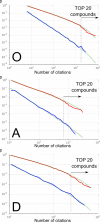Can Invalid Bioactives Undermine Natural Product-Based Drug Discovery?
- PMID: 26505758
- PMCID: PMC4791574
- DOI: 10.1021/acs.jmedchem.5b01009
Can Invalid Bioactives Undermine Natural Product-Based Drug Discovery?
Abstract
High-throughput biology has contributed a wealth of data on chemicals, including natural products (NPs). Recently, attention was drawn to certain, predominantly synthetic, compounds that are responsible for disproportionate percentages of hits but are false actives. Spurious bioassay interference led to their designation as pan-assay interference compounds (PAINS). NPs lack comparable scrutiny, which this study aims to rectify. Systematic mining of 80+ years of the phytochemistry and biology literature, using the NAPRALERT database, revealed that only 39 compounds represent the NPs most reported by occurrence, activity, and distinct activity. Over 50% are not explained by phenomena known for synthetic libraries, and all had manifold ascribed bioactivities, designating them as invalid metabolic panaceas (IMPs). Cumulative distributions of ∼200,000 NPs uncovered that NP research follows power-law characteristics typical for behavioral phenomena. Projection into occurrence-bioactivity-effort space produces the hyperbolic black hole of NPs, where IMPs populate the high-effort base.
Conflict of interest statement
The authors declare no competing financial interest.
Figures






References
-
- Jadhav A.; Ferreira R. S.; Klumpp C.; Mott B. T.; Austin C. P.; Inglese J.; Thomas C. J.; Maloney D. J.; Shoichet B. K.; Simeonov A. Quantitative analyses of aggregation, autofluorescence, and reactivity artifacts in a screen for inhibitors of a thiol protease. J. Med. Chem. 2010, 53 (1), 37–51. 10.1021/jm901070c. - DOI - PMC - PubMed
-
- Qiu F.; McAlpine J. B.; Krause E. C.; Chen S.-N.; Pauli G. F.. Pharmacognosy of black cohosh: the phytochemical and biological profile of a major botanical dietary supplement. In Progress in the Chemistry of Organic Natural Products 99; Kinghorn A. D., Falk H., Kobayashi J., Eds.; Springer International Publishing: Cham, Switzerland, 2014; pp 1–68. - PubMed
Publication types
MeSH terms
Substances
Grants and funding
LinkOut - more resources
Full Text Sources
Other Literature Sources
Miscellaneous

